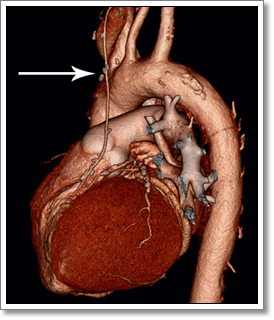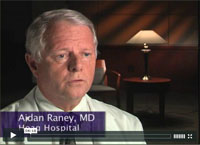Coronary Artery Bypass Surgery
Overview of Coronary Artery Bypass Grafting
Coronary artery bypass grafting (CABG) is an operation that is performed on patients with coronary artery disease. The coronary arteries supply the heart itself with blood. Coronary artery disease occurs when the vessels become narrowed, which is usually due to atherosclerosis. As the vessels become increasingly narrowed, there is less blood flow to the heart, and chest pain occurs (known as “angina”). Patients with severe coronary artery disease also have an increased risk of blood clots forming in the coronary arteries. If a clot forms in the artery, there will be no blood flow to that part of the heart, and a heart attack will occur. In a heart attack, heart muscle begins to die as the lack of blood flow leaves the heart muscle without oxygen.
 Coronary artery bypass grafting (CABG) is a common procedure that may be required in advanced coronary artery disease. Most patients who need a CABG have been seen by a cardiologist, and have undergone coronary catheterization. Coronary catheterization is an exam where dye is injected through a catheter into an artery and x-ray images show the degree of narrowing in the coronary arteries. If there is narrowing in only one artery, the cardiologist may attempt to open the artery with a stent. Patients with severe narrowing of 3 coronary arteries and most patients with diabetes are referred to a heart surgeon for CABG surgery.
Coronary artery bypass grafting (CABG) is a common procedure that may be required in advanced coronary artery disease. Most patients who need a CABG have been seen by a cardiologist, and have undergone coronary catheterization. Coronary catheterization is an exam where dye is injected through a catheter into an artery and x-ray images show the degree of narrowing in the coronary arteries. If there is narrowing in only one artery, the cardiologist may attempt to open the artery with a stent. Patients with severe narrowing of 3 coronary arteries and most patients with diabetes are referred to a heart surgeon for CABG surgery.
The purpose of coronary artery bypass graft surgery is to “bypass” the blocked or obstructed coronary blood vessels with a segment of artery or vein from the patients’ body. The internal mammary artery (IMA), which runs under the breastbone, has the best durability and is the preferred blood vessel to use during the operation. Our surgeons attempt to use the IMA on every coronary bypass operation. As discussed earlier, most patients who have CABG surgery require multiple bypasses on different coronary arteries. The saphenous vein from the leg or radial artery from the arm may also be used to bypass the diseased vessels.
CABG surgery may be performed using traditional “open heart surgery” or with a cutting edge techniques including off-pump bypass surgery and robotic coronary artery bypass surgery. Our surgeons are skilled in traditional as well as these new techniques, which include performing the bypasses with the patient on the heart-lung machine, with the beating heart technique, and with the assistance of robotic surgery. There are advantages and disadvantages to each approach, and we select the best technique depending on the patients' unique characteristics and bypass requirements. Our surgeons also use cutting edge techniques to remove blood vessels from the legs, known as endoscopic vein harvesting. The traditional approach is to make a large incision in the leg to remove the saphenous vein. In endoscopic vein harvesting an instrument with a camera on the end is inserted through a small incision to remove the saphenous vein. This results in less scarring and complications for the patient.
Benefits of Coronary Artery Bypass Grafting
Coronary artery bypass grafting restores blood flow to the coronary arteries. This has two major benefits. First, patients will have relief of chest pain (known as “angina”) that is due to decreased blood flow from narrowed coronary arteries. Secondly, there is decreased risk that the coronary arteries will become completely occluded, which decreases the risk of a heart attack.
Preparing for Coronary Artery Bypass Grafting
All patients will meet with a heart surgeon before coronary artery bypass graft surgery. The surgeon will review the patient’s records and discuss the planned surgery and answer any questions that the patient may have. Prior to your CABG surgery, you will have a full medical evaluation to minimize problems during surgery. This includes a series of lab tests and other procedures. You should bring a list of all medications to your appointment before surgery. Your surgeon will evaluate all your medications and give you specific instructions on which medications to stop prior to your surgery. Please see our section on preparing for heart surgery for more information about preparing for the CABG operation.
How is Coronary Artery Bypass Grafting Performed?
On the day of surgery, you should not wear contact lenses (you can bring your glasses), and you should leave any valuables at home. You will be taken to a “pre-operative” room where you change into a hospital gown. An anesthesiologist (physician responsible for “putting you to sleep” and monitoring during surgery) will talk with you before the surgery. The anesthesiologist will start an IV line prior to surgery which is used to give fluids and medications during the surgery. “General anesthesia” is used to put you to sleep before surgery, where IV and inhaled medications are used to prevent pain and keep you asleep during surgery. You will not remember the events or experience pain during surgery.
Once the patient is asleep, the surgeon typically makes an incision down the middle of the chest and separate the breastbone. This is known as a sternotomy. The patient is placed on “cardio-pulmonary bypass,” where a heart-lung machine is used to do the work of breathing and pumping oxygenated blood for the patient. The patient’s major blood vessels are connected to the heart-lung machine during surgery, which allows the surgeon to operate on the heart without blood flowing through the heart. The heart is then slowed with cooling solution and medications. This allows the surgeon to perform surgery without any beating of the heart. Our surgeons may also use “off-pump” or “beating-heart” techniques. In off-pump bypass surgery, techniques are used to stabilize the heart, and the surgeon performs coronary artery bypass grafting without the heart-lung machine.
The surgeon will prepare blood vessels to be used during the operation. The saphenous vein is removed from the leg, which may be completed using endoscopic vein harvesting, and the internal mammary artery is prepared to be inserted onto the heart. The heart surgeon will then attach the blood vessels to the heart and “bypass” the narrowed portion of the coronary artery. Blood now flows through the new vessel, and goes around the portion of the artery that has disease. Blood flow is restored to the heart muscle. The surgeon carefully sews the heart up after the operation is completed. The heart is then warmed up until it begins to beat on its own, and the patient is taken off the heart-lung machine.
After Coronary Artery Bypass Surgery
After coronary artery bypass surgery, the patient is transferred to the CVICU (Cardiovascular Intensive Care Unit), where specialized staff will closely monitor the patient. A monitoring system is used to closely evaluate the heart rate, rhythm, and vital signs. Medications are provided by the caregiver to control for pain, nausea, and other discomforts the patient may feel. The caregivers will provide specific instructions for starting activity and diet during the recovery phase. Please see our section on recovery from heart surgery for more information.
Risks of Coronary Artery Bypass Grafting
All surgeries are associated with some risk of complications. CABG surgery is considered a major surgical operation, and is associated with risks including: stroke, heart attack, bleeding, infection, nerve damage, breathing problems, drug reactions, blood reactions, arrhythmias and death. Your heart surgeon will discuss these and other risks with you before your operation. Your surgeons and caregivers use many techniques to ensure that these risks are minimized. Fortunately these risks occur in a small percentage of patients undergoing heart surgery.
Our Results in Coronary Artery Bypass Grafting
The surgeons of Raney Zusman Medical Group have experienced excellent results in heart bypass surgery, with the yearly mortality continually below the statewide average for California.
 Email Article
Email Article 
